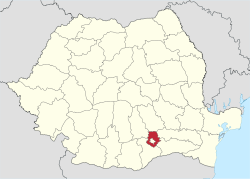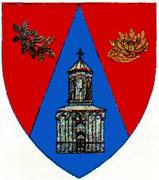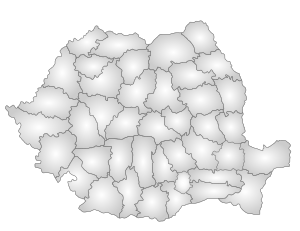Ilfov County
| Ilfov County Județul Ilfov | ||
|---|---|---|
| County | ||
| ||
 | ||
| Coordinates: 44°37′N 26°07′E / 44.61°N 26.12°ECoordinates: 44°37′N 26°07′E / 44.61°N 26.12°E | ||
| Country | Romania | |
| Development region | București-Ilfov | |
| Historical region | Muntenia | |
| Area | ||
| • Total | 1,583 km2 (611 sq mi) | |
| Area rank | 41st | |
| Population (2011) | ||
| • Total | 388,738 | |
| • Rank | 25th | |
| • Density | 250/km2 (640/sq mi) | |
| Telephone code | (+40) 21 or (+40) 31[1] | |
| ISO 3166 code | RO-IF | |
| Website |
County Council Prefecture | |
Ilfov (Romanian pronunciation: [ˈilfov]) is the county that surrounds Bucharest, the capital of Romania. It used to be largely rural, but, after the fall of communism, many of the county's villages and communes developed into high-income commuter towns, which act like suburbs or satellites of Bucharest. The gentrification of the county is continuing, with many towns in Ilfov, such as Otopeni, having some of the highest GDP per capita levels in the country.
Demographics
It has a population (excluding Bucharest) of 364,241. The population density is 230.09 per km². 40% of the population commutes and works in Bucharest, although, in recent years, many industrial plants were built outside Bucharest, in Ilfov county. It has an annual growth of about 4%.
| Year | County population[3][4] |
|---|---|
| 1948 | 167,533 |
| 1956 | |
| 1966 | |
| 1977 | |
| 1992 | |
| 2002 | |
| 2011 |
Geography
The county has an area of 1,583 km² and it is situated in the Romanian Plain between the Argeș River and the Ialomița River.
The main rivers that pass through the county are: Dâmbovița River, Colentina River and Gruiu River. Several lakes can be found in Ilfov county, notably Lake Cernica, Lake Snagov and Lake Căldărușani.
Neighbours
- Prahova County in the north.
- Ialomița County in the east.
- Călărași County in the southeast.
- Giurgiu County in the southwest.
- Dâmbovița County in the west.
Economy
The base occupation used to be the agriculture. Nowadays, due to the economical growth in Bucharest, many companies have opened their offices, production facilities or warehouses in the nearby villages, situated in the Ilfov County, thus making it the most developed county in Romania.
The predominant industries in the county are:
- Food and beverages industry
- Textile industry
- Mechanical components industry
- Chemical industry
- Paper industry
- Furniture industry
- Rubber industry
- Electrical equipment industry
- Transport equipment industry
- Electronic and optical equipment
At Otopeni there is the main aerial transport hub in Romania - the Henri Coandă International Airport. Also all the main roads and railways leaving Bucharest pass through the county.
Tourism
The county has a large surface covered with forests and also due to its lakes, it is a frequent week-end and holiday destinations for the inhabitants of Bucharest.
Other notable touristic sites are:
- The Snagov Monastery
- The Cernica Monastery
- The Mogoșoaia Palace
- The Căldărușani Monastery
- The Ghica family palace in Moara Vlăsiei
- The Știrbei Palace in Buftea
Politics
The Ilfov County Council, elected at the 2016 local government elections, is made up of 33 counselors, with the following party composition:[5]
| Party | Seats | Current County Council | ||||||||||||||||
|---|---|---|---|---|---|---|---|---|---|---|---|---|---|---|---|---|---|---|
| National Liberal Party | 16 | |||||||||||||||||
| Social Democratic Party | 12 | |||||||||||||||||
| Alliance of Liberals and Democrats | 3 | |||||||||||||||||
| People's Movement Party | 2 | |||||||||||||||||
History
Most of today's Ilfov County used to be covered by Codrii Vlăsiei, a thick forest, but there were several Dacian settlements, most important being Argedava, on the right bank of the Argeș River in what is now Popești, which was the capital of king Burebista.
The thick forests were useful for retreat during the migration age because they were not easy to cross on horseback. In fact, the name of the forest means "the Forests of the Vlachs" (Romanians), a name given by the Slavs who inhabited the nearby plains.
The county was named after the Ilfov River and it appears for the first time in a 1482 donation act of voivode Vlad Călugărul to the monastery of Snagov. In earliest documents, it was known as Elhov. The name is of Slavic origin, being derived from елха, elha (alder) and possessive suffix -ov, referring to a river which flowed through an alder forest.[6]
Administrative divisions
The county has 8 towns and 32 communes.
There were serious debates about the city level awarded to Voluntari, as it is alleged that it was given in regard to the city's political affiliation, rather than population, development or any other objective features. Despite this, Voluntari does have a population of 30,000, and many other localities with this population have been given city-status in the past.
Before 1972, it used to be one of the largest counties of Romania, but parts of it were added to neighbouring counties and nowadays it is the smallest (excluding the city of Bucharest, which has a special status). Between 1981 and 1997, it was called "Sectorul Agricol Ilfov" and it was not a separate county, but subordinate to the capital.

- Periș
- Ciolpani
- Gruiu
- Nuci
- Snagov
- Grădiștea
- Moara Vlăsiei
- Balotești
- Corbeanca
- Dascălu
- Petrăchioaia
- Otopeni (town status)
- Tunari
- Ștefăneștii de Jos
- Afumați
- Voluntari (town status)
- Găneasa
- Mogoșoaia
- Buftea (town status)
- Chitila (town status)
- Dragomirești-Vale
- Chiajna
- Dobroești
- Pantelimon (town status)
- Brănești
- Ciorogârla
- Domnești
- Clinceni
- Bragadiru (town status)
- Popești-Leordeni (town status)
- Glina
- Cernica
- Cornetu
- Măgurele (town status)
- Jilava
- Berceni
- Dărăști-Ilfov
- 1 Decembrie
- Vidra
Ilfov County is the only county that has its capital outside of its territorial area, in Bucharest which is not part of the actual county. Initially, immediately after the 1968 reform of the public administration in communist Romania, Ilfov was a larger county, that comprised its present-day territory, the entire Giurgiu County, Bucharest and the western parts of Călăraşi and Ialomiţa counties. Later during the communist period, its territory was reduced to its current size and it became one of the sectors of Bucharest. It became again a county in 1997, when its capital was designated to be Bucharest.[7][8] However, in 2005, some plans were proposed that would merge Bucharest with 90 other communes located to up to 40 km outside the city, in Ilfov County and other nearby counties into a "metropolitan area" of Bucharest.[9] As of 2011, these plans have not come true, while a debate on the general administrative division of Romania was under way.
References
| Wikimedia Commons has media related to Ilfov County. |
- ↑ The number used depends on the numbering system employed by the phone companies on the market.
- ↑ National Institute of Statistics, "Populația după etnie"
- ↑ National Institute of Statistics, "Populația la recensămintele din anii 1948, 1956, 1966, 1977, 1992 și 2002"
- ↑ 2011 Romanian Census Results
- ↑ "Mandate de CJ pe judete si competitori" (in Romanian). Biroul Electoral Central. 10 June 2016. Retrieved 16 June 2016.
- ↑ Constantin C. Giurescu, Istoria Bucureștilor. Din cele mai vechi timpuri pînă în zilele noastre, Bucharest, 1966, p. 38
- ↑ "Law no. 50/1997 in Romania". Retrieved 2011-08-01.
- ↑ "Law no. 50/1997 in Romania". Camera Deputaţilor. Retrieved 2011-08-01.
- ↑ Alexandru, Cristina. "Bucureștiul va înghiți localitățile din jur". Biz Magazine. nr 110; 15 September 2005

